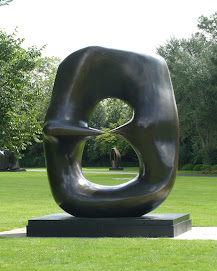Most people are familiar with the mathematics of the Renaissance artists, such as the use of the Golden Ratio. For example, Leonardo da Vinci used a complex formula based on the relationship 12:6:4:3. These ratios are also very present in music. 3:4 is the interval of one fourth, and 4:6 is a fifth etc. He thought making use of this ratio would “offer praise to the harmonies of the universe".
Naum Gabo Linear Construction No. 2 1970-71 Plastic and nylon filament (Sa) object 1149 x 835 x 835 mm

Modern Art is also prolific in the use the mathematics.Two very different artistic movements, the surrealists and the constructivists, discovered mathematical models at approximately the same time. Constructivist Naum Gabo began to draw direct inspiration from the forms of mathematical models in the early 1930’s. Surrealist photographer and painter Man Ray did a series of photographs in 1936 of mathematical models housed at the Poincaré Institute in Paris.
Henry Moore Stringed Figure, 1937
cherry wood and string on oak base
Henry Moore (1893-1986) used string in many of his sculptures for a short period of time, and this was influenced by stringed models that he had seen at the Science Museum in London. As Moore himself says: Undoubtedly the source of my stringed figures was the Science Museum...I was fascinated by the mathematical models I saw there, which had been made to illustrate the difference of the form that is halfway between a square and a circle. One model had a square at one end with twenty holes along each side, making eighty holes in all. Through these holes strings were threaded and lead to a circle with the same number of holes at the other end. A plane interposed through the middle shows the form that is halfway between a square and a circle. One end could be twisted to produce forms that would be terribly difficult to draw on a flat surface. It wasn't the scientific study of these models but the ability to look through the strings as with a bird cage and see one form within the other which excited me. [Moore, p. 105]
Barabara Hepworth also had a close and productive relationship with J.D. Bernal, a crystallographer who was interested in the relationship between art and science. Apparently, Hepworth enjoyed visits from Bernal, during which he would discuss with her the mathematics and geometry in her works [Barlow]. Hepworth had an interest in "higher geometry" and she probably viewed the models at the school in Oxford herself, but the exact influence of the models in unclear.





![Objet Mathematique [Mathematical object], 1934-36](https://blogger.googleusercontent.com/img/b/R29vZ2xl/AVvXsEjLj3RbKwEsBQ9_oXAT8tJF4nqp-uvyD5k1gCCLHBM_b-FZsKFEu5Noon_p_mT_vcKWjWmTGpiLj-nxAv1VZpI_ITC5X-Q51T9wXr-Uzpb3xBtMpY_E_FqpW0ard-_7d4BrcTkb-2ASQUM/s264/00objet_math.gif)

4 comments:
On Squares
Your opening statement perplexed me, somewhat. From my perspective of a person, reduced to art appreciation, not creation, the judgmental dichotomy “use – abuse” does not apply to artist's choice. I propose “employ and exploit” as a way to establish semantic equilibrium. (As an aside, the blame for overusing, misusing, and abusing judges should fall - these days - on the Senate.) Yet, accusations of abuse against artists by general public, art critics, and fellow artists abounded through history. Such was the case of
Kazimir Malevich, the founder of the Suprematism, who expressed his aesthetic principle in his manifesto From Cubism to Suprematism. Black Square, 1915, and Suprematist Composition: White on White. 1918, are his emblematic works.
http://www.russianavantgard.com/Artists/malevich/malevich_black_square_tg.jpg
http://www.moma.org/explore/multimedia/audios/3/53
Utilizing abstract geometric forms, he purified art of the residue of things, thus establishing its superiority over objects. If meditation is a space between two thoughts, Malevich's contrived reductionism seeks higher meaning.
The tradition of non-objective art continued in the works by Josef Albers whose “oeuvre reflects an adherence to the deceptively simple principle of visual economy. His paintings commence as objective, mathematically precise constructions, involving straight lines and angles, that form the foundation for his principle concern, the subjective relationship of color and form. His art proves that there is a “world between physical fact and psychic effect.” (“Homage to the Square: Nocturne, 1951.” The James A. Michnener Collection. UT-Austin, 1977. 5.) See The Josef & Anni Albers Foundation site for further information:
http://www.albersfoundation.org/Home.php
Cubism: Flashback
What other art movements, design schools, aesthetical styles should we cite to bridge the gap between Leonardo and the 21st century? How old is Cubism? Did it start with the work of Cézanne? Did it unfold its analytical potential in Picasso’s paintings? Does it essentially mean a combination of geometrical basics with color? Do monochrome drawings from the Baroque period belong here? Timewarps into the art history are worth performing as they reveal amazing evidence of artists’ fascination with mathematical concepts, to wit:
Giovanni Battista Bracelli, the 17th century Italian engraver ( see reference in 16th and 18th Century Digital Materials from the Lessing J Rosenwald Collection (Rosenwald 1345), the Library of Congress:
http://www.loc.gov/rr/rarebook/rosenwald-16cen18cen.html
Luca Cambiaso. A Group of Cubist Figures, 1560.
http://3.bp.blogspot.com/_qTDAEasFLtU/RlsI9t4TKdI/AAAAAAAADKI/o1HrIlYI_SM/s400/Luca+Cambiaso.jpg
Notably, this Cubist drawing was chosen to illustrate the post (in Spanish) that seeks to find appropriate places for happiness and suffering in human life.
http://entrepintoyvaldemoro.blogspot.com/2008_04_01_archive.html
The art history shows how mathematical concepts came to rescue art from crises.
The "Head of a Woman" piece was the one piece that jumped out at me the most i love that it was made out of cardboard!!
I've always been interested in how those pieces were made, they are so precise and amazing. I should have known math had to do with it! Math and Art surprisingly go hand in hand.
Post a Comment